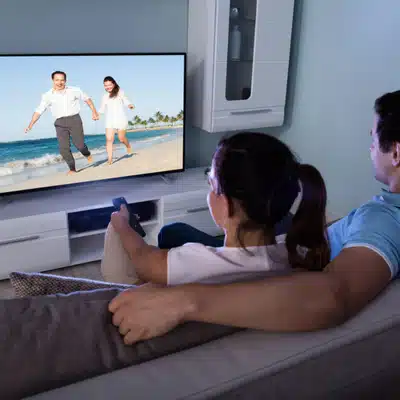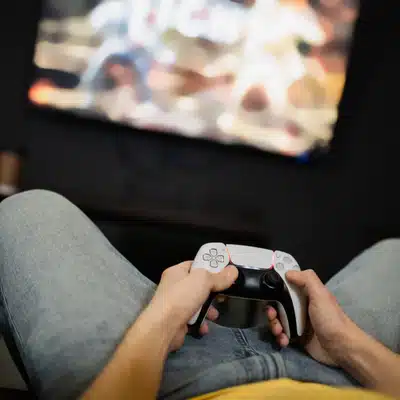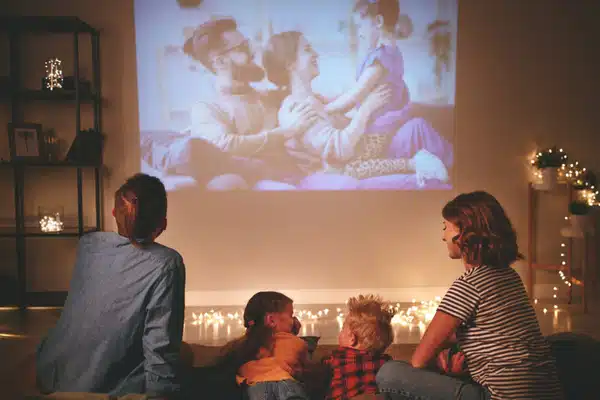Building a home cinema raises one question: projector or TV? Both offer stunning visuals and smart features. They differ in screen size, performance, setup, and cost. This guide covers brightness, color accuracy, gaming performance, and maintenance.
Screen Size and Immersion

Projectors win on screen size. Most TV screens max out around 85 to 100 inches. Home theater projectors create images from 120 to 300 inches. Even budget projectors easily hit 100-inch sizes. The result? Pure immersion.
Moving from 100 to 120 inches adds 44% more viewing area. Only projectors reach these screen size levels in homes. Large picture size gives you true theater feel.
Large projector screens give wide viewing angles. Quality screens reflect images evenly, so everyone sees great picture quality. Traditional LED and LCD TV screens lose brightness and color accuracy from side angles. OLED TVs handle viewing angles better.
You need a proper viewing distance. A 120-inch 4K screen looks great from close up. The throw distance between the projector and the screen must work for your screen size. Short-throw projectors sit inches from walls. They solve placement and throw distance problems.
Picture Quality: Brightness, Color, and Contrast
High-end TVs beat projectors on picture quality. TVs shine in brightness and contrast. OLED and mini-LED TVs achieve deep black levels and bright highlights. Projectors bounce light off screens using lumens of light output. This limits brightness and contrast ratio.
Projectors look great in dark rooms. Modern units pump out enough brightness for controlled lighting. But TVs crush projectors in bright spaces. Dark scenes look washed out. TVs keep consistent brightness during daytime viewing.
Ambient light kills projection quality. TVs beat projectors in bright rooms. Dark content on projectors looks terrible. Projectors need dark room performance. You can control ambient light with curtains. But in bright conditions, projectors fade. Ambient light remains the enemy of projected images.
TVs win on contrast. OLED and LED models achieve deeper black levels. Black levels on TVs go darker.
HDR content pops more on TVs. Bright highlights have more impact. One test showed projectors “blew out” bright clouds in Dolby Vision HDR. The TV showed them perfectly. HDR on projectors falls short. Many support HDR10 and Dolby Vision. But they can’t match TVs for HDR color and contrast. Good HDR performance needs higher brightness.
Regular content differs. Good projectors deliver great color saturation and contrast. Tests found calibrated projectors slightly better in 98% of scenes. They showed better color saturation. Proper color saturation brings movies to life.
Top projectors use 3-chip designs or laser sources. Triple-laser projectors hit high color accuracy standards. With proper setup, projectors deliver outstanding image quality. The viewing experience looks filmic.
Projectors need dark rooms with dark walls. This boosts perceived contrast. TVs use high-contrast panels to look punchy anywhere. Both provide image sharpness when set up right.
Both 4K TVs and 4K projectors look sharp. TVs excel at upscaling HD content to 4K resolution. Projectors can be just as sharp.
TVs offer many picture options out of the box. Projectors may need calibration for perfect results.
Installation, Setup, and Placement
Setup differs greatly. Large TVs are simple. Mount them on walls. Plug in power.
Projector setup takes more work. You must position the unit properly. Most handle mounting projectors to ceilings. Then align the image. Modern projectors include auto-focus. The setup process got faster.
Projectors give you flexibility. You can hide screens in ceilings. But projectors need good placement planning.
Smart Features, Connectivity, and Audio
TVs rule smart features. Nearly all modern TVs have built-in smart features. You get streaming apps and voice control.
Most projectors lack built-in platforms. You need external streaming devices. Some newer projectors include Android TV or smart features. External streamers are cheap and work great.
Connectivity matters for both. Look for multiple HDMI ports. HDMI 2.1 supports 4K at high refresh rates. Most include audio outputs. However, dedicated theater audio systems sound better for both.
Neither projectors nor TVs excel at audio alone. Budget for proper sound in either setup.
Gaming Performance

Gaming works on both. But TVs win for serious gamers. Modern TVs offer low input latency. They support 120Hz or higher refresh rates. These gaming features matter for competitive play. Lower refresh rates cause motion blur.
Many projectors support decent speeds. That’s fine for casual gaming. The huge screen creates immersion. But TVs deliver faster response times.
For casual gamers, projectors work great. For competitive gaming, TVs have the edge.
Cost Comparison
Price varies widely. Both can be cheap or expensive. Projectors give you more screen size per dollar. A good 4K projector is affordable. Add a quality screen. That’s less than massive TVs.
Large TVs get expensive fast. Top models carry a hefty price tag. The cost per inch favors projectors.
Entry-level projectors are budget-friendly. But that projector creates bigger pictures.
High-end projectors with laser sources cost more. But you get reference images at huge sizes. No TV matches that screen size at any cost.
Projectors win on value for large screens.
Portability, Maintenance, and Lifespan
Projectors offer more portability. Many models are lightweight. You can move them between rooms. This portability makes projectors flexible. TVs stay put. So projectors win on portability.
Projector screens retract into ceilings. Motorized screens drop down when needed.
Traditional projectors use lamps that die after several thousand hours. Replacement lamps add to ownership cost. Laser projectors last much longer. No lamp replacements needed. Fan noise can be noticeable. Some produce annoying fan noise during operation.
TVs need almost zero maintenance. Modern TVs last many years. No bulb changes. TVs outlast lamp-based projectors with no ongoing costs. Laser projectors match TVs for lifespan.
Projectors need occasional filter cleaning. Keep the lens dust-free. But projector maintenance isn’t hard. Regular maintenance keeps your projector running well.
Power use favors projectors for large screens. Big TVs draw more power.
Choosing the Right Option
Projector vs TV: Choose Your Perfect Home Theater
Match your display to your viewing habits and room setup
Choose Projector If:
Choose TV If:
Your choice depends on viewing habits, room setup, and priorities. Do you want the biggest screen for immersion? Do you have a dark room? Projectors deliver an unmatched home cinema atmosphere. Many Waco homeowners pick projectors for theater rooms. Even 85-inch TVs can’t match the home cinema experience.
Does your theater space double as a living room? Do you watch with the lights on often? A big TV might serve you better.
TVs are instant-on with no alignment worries. They provide steady performance with minimal maintenance. Projectors offer flexibility. You get a larger picture size for less money. However, projectors require more effort and maintenance time.
For gamers, competitive gaming needs advanced features and high speeds. Casual big-screen gaming is wonderful on projectors. Consider what matches your viewing habits best.
Both create stunning quality in the right conditions. One expert found that “in a perfect dark room, a TV is just as good if not better than a projector. In a bright room, the TV is clearly superior. In a dim room, it depends.”
When comparing TV projector picks, think about your space. Dark dedicated theaters favor projectors. Multi-use rooms favor TVs.
Transform Your Home Theater Today

Ready to build your dream theater? Stop settling for average entertainment. My Custom Integrators designs and installs premium systems across Texas. We work with both projector setups and large-screen TV installations. Our team evaluates your space.
Want the immersive canvas of a projector? Or the convenient brightness of a TV? We create spectacular home theaters that fit your lifestyle. Book your free consultation now.
Contact My Custom Integrators today. Your personal home cinema awaits.
Frequently Asked Questions
Do projectors work well in rooms with windows?
Projectors struggle in rooms with lots of ambient light. Even high-lumen models with special screens can’t match TVs in bright spaces. Dark scenes look washed out. You need to control the light with blackout curtains. Projectors shine in dedicated dark rooms. If your space has many windows, a TV handles daytime viewing better.
How long do projector bulbs last compared to TVs?
Traditional projector lamps last several thousand hours before needing replacement. That’s roughly a few years with regular use. Replacement bulbs add to ownership costs. Laser projectors last much longer with no bulb changes needed. TVs need almost no maintenance and last many years. Laser projectors match TV lifespan while lamp-based models have higher costs.
Can I use a projector for gaming?
Yes, projectors work great for gaming. Many newer models support good speeds and have reasonable latency. That’s fine for casual gaming. The huge screen creates amazing immersion. But competitive gamers should pick TVs. They offer lower latency and more advanced features.
What screen size should I choose for my room?
For 4K displays, you can sit fairly close without seeing pixels. A common guide suggests sitting 1.5 times the screen width away. Make sure your room accommodates both the distance and projection needs. Bigger isn’t always better if you sit too close or your room can’t fit proper mounting.

